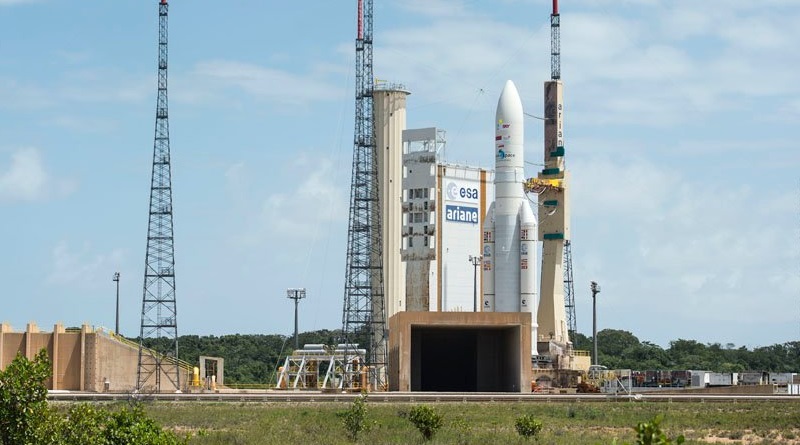Ariane 5 Rocket in the Launch Zone for first Heavy-Lift Mission of 2017
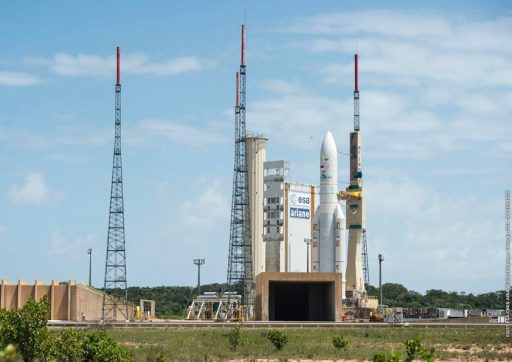
Europe’s Ariane 5 heavy-lift rocket stands tall atop its French Guiana launch pad in anticipation of the year-opening launch of the workhorse on Tuesday, carrying into orbit a pair of communications satellites for Brazil and Indonesia. The rocket’s 86-minute launch window opens at 21:39 UTC and it will take the rocket just under 40 minutes to drop over nine metric tons off in a highly elliptical Geostationary Transfer Orbit.
Tuesday’s launch marks the first of seven planned Ariane 5 missions in 2017 and is part of the bread-and-butter business for the Ariane 5, lifting a pair of communications satellites into Geostationary Transfer Orbit. Six of the planned launches will be with pairs of satellites headed to GTO; the remaining mission will involve an Ariane 5 ES launcher lifting four Galileo navigation satellites directly into a Medium Earth Orbit.
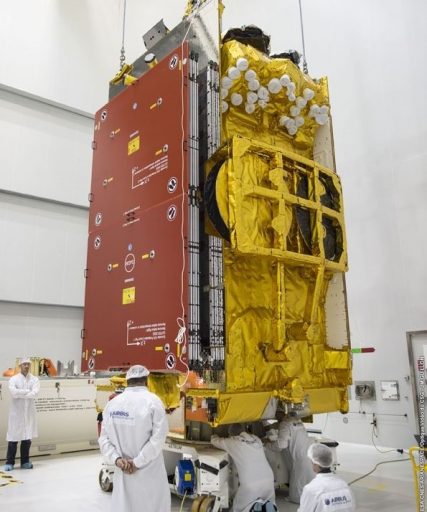
Passengers of Tuesday’s Ariane 5 mission are SKY Brasil-1 operated by DirecTV Latin America and Telkom 3S for Indonesia’s state-owned PT Telekom. The launcher is carrying a total payload of 10,482 Kilograms including the two satellites and associated payload adapters hidden under the 17-meter tall payload fairing. SKY Brasil-1, the heavier of the two satellites weighing in at around six metric tons, is sitting in the upper payload berth while the 3,550kg Telkom 3S will make its way into orbit under the Sylda adapter that allows Ariane 5 to carry two satellites in a stacked configuration.
SKY Brasil-1 was built by Airbus Defence and Space based on the flight-proven Eurostar E3000 satellite platform and employs a hybrid propulsion system for an extended service life of 19 years. The satellite carries 81 transponders – 61 Ku-Band transponders operated by AT&T / DirecTV Latin America to deliver HDTV, 3D and cinema broadcasting in South and Latin America while 20 high-power Ka-Band transponders are under operation by YahSat to expand the company’s reach beyond Arabian markets.
The Ku-Band payload is focused on countrywide coverage in Brazil and will be used to ensure a continuation of DirecTV legacy digital TV services and expansion into HD and 3D markets. Twenty spot beams will be available for the distribution of regional TV channels.
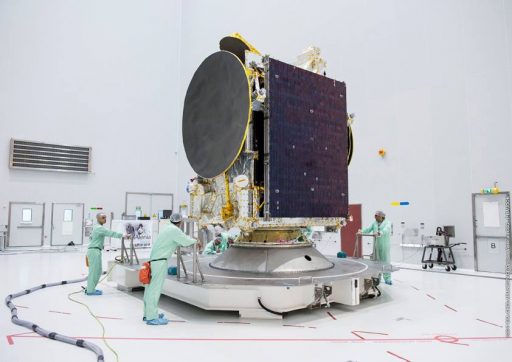
Telkom 3S is the replacement for the Telkom 3 satellite that ended up in a useless orbit in a botched August 2012 launch atop a Proton-M/Briz-M launch vehicle with no prospects of getting anywhere close to its operational orbit. The replacement was ordered from Thales Alenia in 2014, employing the Spacebus 4000B2 satellite platform suitable for medium-power communications satellites. It hosts a hybrid payload of 24 standard C-Band, eight extended C-Band and ten Ku-Band transponders to deliver HD television, mobile communications and remote Internet services across the Indonesian territory. C-Band coverage from the satellite stretches across a large portion of southeast Asia, the extended C-Band coverage area extends across Indonesia and portions of Malaysia while Ku-Band coverage is focused on Indonesia.
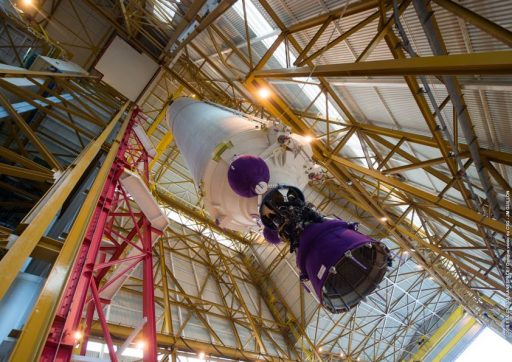
Preparations for Ariane’s year-opening mission started in early November 2016 when the Ariane 5 rocket was delivered to the Guiana Space Center by the MN Colibri, one of two cargo ships in charge of transporting rocket components from Europe to South America.
Integration of the 55-meter tall vehicle started in the second half of December when the large EPC Cryo Core was installed atop one of two operational launch tables. The next step was the attachment of the twin EAP Solid Rocket Boosters after each was stacked at a separate facility. Finally, the ESC-A second stage was hoisted atop the core stage to finish the basic build-up of the rocket and allow it to move over to the Final Assembly Building.
The two passengers for mission VA235 were delivered by two cargo planes flying in from Europe to begin a four-week final processing campaign at the launch site to undergo checkouts and propellant loading before being integrated into the mission’s payload stack. Fueling of the satellites wrapped up by February 6 and, over the next four days, Telkom 3S took its spot directly atop the rocket’s second stage while SKY Brasil-1 was first integrated with the Sylda Adapter and Payload Fairing before the assembly was lifted atop the Ariane 5 rocket.
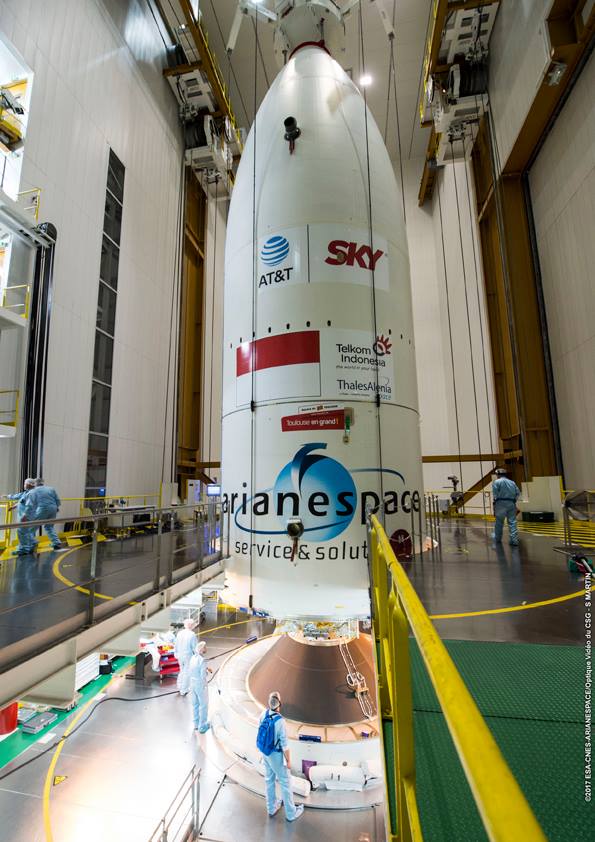
Arianespace officials convened for the Launch Readiness Review on Friday and found no red flags that could come in the way of liftoff, allowing Ariane 5 to proceed into final arming before departing its Final Assembly Building on Monday. The rocket completed a 2.7-Kilometer trip in the afternoon hours, slowly rolling to its ELA-3 launch pad to enter the final 24 hours to launch, a well-rehearsed operation that gets the rocket ready for propellant loading and liftoff.
The countdown will formally kick off at 10:16 UTC on Tuesday, eleven hours and 23 minutes prior to the opening of the day’s launch window. Initial countdown operations include final close outs of the launch facility and power-up of the Ariane 5 rocket for several hours of detailed checks of the various subsystems to ensure the control system of the vehicle is operating to specification.
Propellant loading is initiated five hours prior to T-0 with the chilldown of transfer lines and propellant tanks before supercold Liquid Oxygen stored at -183°C and Liquid Hydrogen at -253°C are pumped into the two stages of the rocket. The 30.5-meter tall first stage will enter propellant loading first at T-4 hours and 23 minutes followed 40 minutes later by the second stage. Loading of the rocket with 184 metric tons of propellant will take approximately two hours and tanks will be kept at flight level throughout the rest of the countdown.
A repetition of telemetry checks occurs inside L-90 minutes ahead of the final set of preparatory steps to get Ariane 5 and all ground systems ready for the seven-minute Synchronized Sequence. Switching into fully computer-controlled mode, Ariane 5 will check off its final countdown milestones – notably the pressurization of tanks, the transfer to internal power, pyrotechnics activation and the handoff to Ariane’s computers four seconds before ignition.
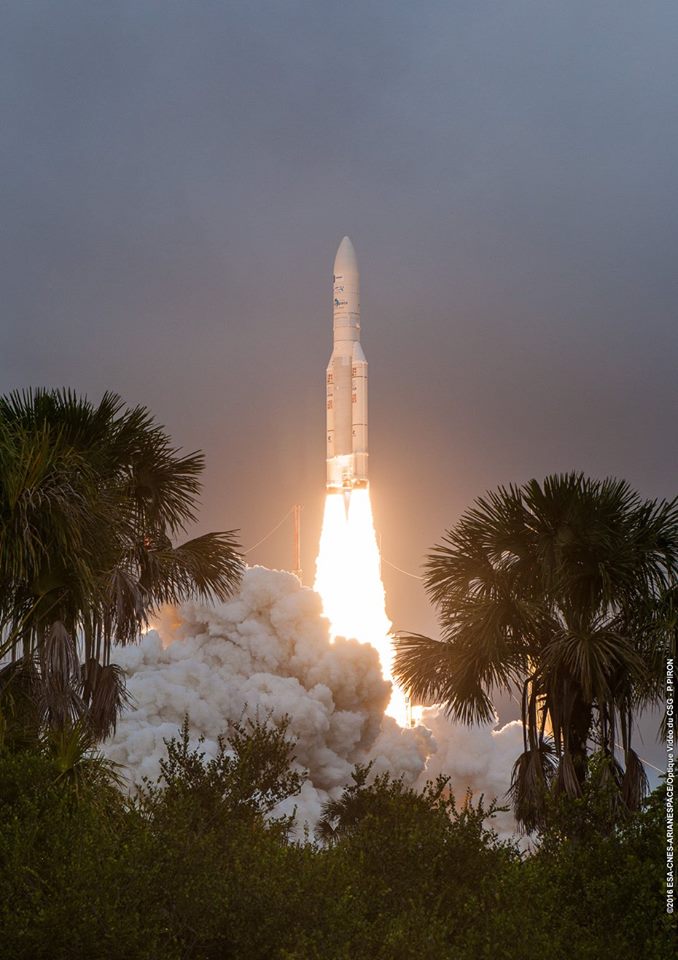
When clocks hit zero, the Vulcain 2 engine will ignite to soar to a launch thrust of 960 Kilonewtons with seven seconds of engine monitoring before the twin Solid Rocket Boosters are ignited – marking the point of no return.
Upon ignition of the boosters, Ariane 5 will jump off its launch pad with a thrust of 1,420 metric ton force – balancing in a vertical posture for less than ten seconds before initiating its pitch and roll programs to align itself with a due easterly departure path for a quick flight across the Atlantic Ocean.
The EAP boosters will deliver over 90% of the vehicle’s total thrust, each burning through 237 metric tons of propellant to help accelerate Ariane 5 to a speed approaching two Kilometers per second. Ariane 5 will push through the speed of sound just 49 seconds into the flight and experience maximum dynamic pressure just after passing the T+1-minute mark.
The twin boosters will separate from the still-firing core stage at T+2 minutes and 20 seconds, using a pyrotechnic separation system to drop away from the rocket, headed toward a crash landing in the Ocean. With the boosters gone, it will be up to the Vulcain 2 engine to continue pushing Ariane 5 towards orbit with a vacuum thrust of 136 metric ton-force.
The protective payload fairing will be jettisoned three minutes and 21 seconds into the flight when Ariane 5 will have departed the discernible atmosphere. Shutdown of the core is expected at T+8 minutes and 55 seconds with separation of the spent rocket stage seven seconds later to clear the way for the critical second stage burn. Ignition of the HM-7B engine will come four seconds after staging on a burn of 16 minutes and 11 seconds to push the stack into a highly elliptical orbit with a thrust of over six metric tons.
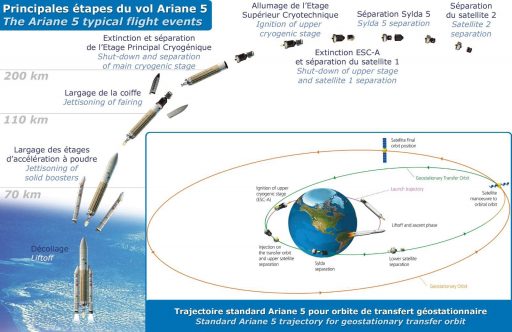
The VA235 mission is targeting an orbit of 250 by 35,736 Kilometers, inclined 4.0 degrees with the upper stage aiming for an injection speed of 9.4 Kilometers per second. Powered flight will end at T+25 minutes and 16 seconds, marking the start of the complex ballistic phase to prepare for the separation of the satellites.
SKY Brasil-1 will depart the Ariane 5 rocket 27 minutes and 25 seconds into the mission with the second stage swiftly swinging around to set up for the jettisoning of the Sylda adapter just two minutes later. Telkom-3S will remain attached for another ten minutes while the second stage maneuvers into the proper position for the release of the smaller of the two passengers just shy of T+40 minutes to conclude the 91st flight of the Ariane 5 rocket.

